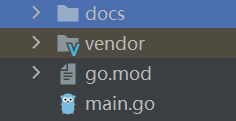gin配置swagger
不多说废话,直接开始 准备工作:
- 下载swag for go
go get -u github.com/swaggo/swag/cmd/swag
- 然后执行
swag init
你就会发现自己的项目中多出一个
docs
文档文件
- 下载 gin-swagger
go get -u github.com/swaggo/gin-swagger
go get -u github.com/swaggo/files
- 在你的代码中引入
import "github.com/swaggo/gin-swagger" // gin-swagger middleware
import "github.com/swaggo/files" // swagger embed files
测试:
测试方法:
// PingExample godoc
// @Summary ping example
// @Schemes
// @Description do ping
// @Tags example
// @Accept json
// @Produce json
// @Success 200 {string} Helloworld
// @Router /example/helloworld [get]
func Helloworld(g *gin.Context) {
g.JSON(http.StatusOK,"helloworld")
}
当这个方法存在时,再次使用
swag init
将会更新文档中的信息
如果要使用这个文档就要先引用
import (
docs "GinTest/swag/docs"
)
然后再
main.go
中配置swagger
func main() {
r := gin.Default()
docs.SwaggerInfo.Title = "Swagger Example API"
docs.SwaggerInfo.Description = "This is a sample server Petstore server."
docs.SwaggerInfo.Version = "1.0"
docs.SwaggerInfo.Host = "localhost:8080"
docs.SwaggerInfo.Schemes = []string{"http", "https"}
docs.SwaggerInfo.BasePath = "/api/v1"
v1 := r.Group("/api/v1")
{
eg := v1.Group("/example")
{
eg.GET("/helloworld",Helloworld)
}
}
r.GET("/swagger/*any", ginSwagger.WrapHandler(swaggerfiles.Handler))
r.Run(":8080")
}
此时的项目结构为

启动项目,然后访问
http://localhost:8080/swagger/index.html
这时你就会看到

所有代码和命令
需要安装
go get -u github.com/swaggo/swag/cmd/swag
go get -u github.com/swaggo/gin-swagger
go get -u github.com/swaggo/files
需要在代码中导入的
import "github.com/swaggo/gin-swagger" // gin-swagger middleware
import "github.com/swaggo/files" // swagger embed files
import docs "GinTest/swag/docs" // your docs
测试代码:
package main
import (
docs "GinTest/swag/docs"
"github.com/gin-gonic/gin"
swaggerfiles "github.com/swaggo/files"
ginSwagger "github.com/swaggo/gin-swagger"
"net/http"
)
// @BasePath /api/v1
// PingExample godoc
// @Summary ping example
// @Schemes
// @Description do ping
// @Tags example
// @Accept json
// @Produce json
// @Success 200 {string} Helloworld
// @Router /example/helloworld [get]
func Helloworld(g *gin.Context) {
g.JSON(http.StatusOK,"helloworld")
}
func main() {
r := gin.Default()
docs.SwaggerInfo.Title = "Swagger Example API"
docs.SwaggerInfo.Description = "This is a sample server Petstore server."
docs.SwaggerInfo.Version = "1.0"
docs.SwaggerInfo.Host = "localhost:8080"
docs.SwaggerInfo.Schemes = []string{"http", "https"}
docs.SwaggerInfo.BasePath = "/api/v1"
v1 := r.Group("/api/v1")
{
eg := v1.Group("/example")
{
eg.GET("/helloworld",Helloworld)
}
}
r.GET("/swagger/*any", ginSwagger.WrapHandler(swaggerfiles.Handler))
r.Run(":8080")
}
注释格式请参考:
通用API信息
gin-swagger项目官网:
gin-swagger